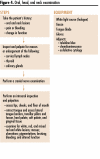Screening for and diagnosis of oral premalignant lesions and oropharyngeal squamous cell carcinoma: role of primary care physicians
- PMID: 18556495
- PMCID: PMC2426981
Screening for and diagnosis of oral premalignant lesions and oropharyngeal squamous cell carcinoma: role of primary care physicians
Abstract
OBJECTIVE; To describe the role that primary care physicians can play in early recognition of oral and oropharyngeal squamous cell carcinomas (OOSCCs) and to review the risk factors for OOSCCs, the nature of oral premalignant lesions, and the technique and aids for clinical examination.
Quality of evidence: MEDLINE and CANCERLIT literature searches were conducted using the following terms: oral cancer and risk factors, pre-malignant oral lesions, clinical evaluation of abnormal oral lesions, and cancer screening. Additional articles were identified from key references within articles. The articles contained level I, II, and III evidence and included controlled trials and systematic reviews.
Main message: Most OOSCCs are in advanced stages at diagnosis, and treatment does not improve survival rates. Early recognition and diagnosis of OOSCCs might improve patient survival and reduce treatment-related morbidity. Comprehensive head and neck examinations should be part of all medical and dental examinations. The head and neck should be inspected and palpated to evaluate for OOSCCs, particularly in high-risk patients and when symptoms are identified. A neck mass or mouth lesion combined with regional pain might suggest a malignant or premalignant process.
Conclusion: Primary care physicians are well suited to providing head and neck examinations, and to screening for the presence of suspicious oral lesions. Referral for biopsy might be indicated, depending on the experience of examining physicians.
OBJECTIF: Décrire le rôle éventuel du médecin de première ligne dans la détection des épithéliomas malpighiens spinocellulaires oraux et oro-pharyngés (ÉMSOO) et revoir les facteurs de risque associés, la nature des lésions orales précancéreuses, et les techniques et outils facilitant l’examen clinique.
QUALITÉ DES PREUVES: On a répertorié MEDLINE et CANCERLIT à l’aide des rubriques suivantes: oral cancer and risk factors, pre-malignant oral lesions, clinical evaluation of abnormal oral lesions, et oral cancer screening. Des articles additionnels ont été identifiés à partir des références-clés des articles. Les articles présentaient des preuves de niveaux I, II et III, et incluaient des essais randomisés et des revues systématiques.
PRINCIPAL MESSAGE: La plupart des ÉMSOO sont à un stade avancé au moment du diagnostic, et le traitement n’améliore pas le taux de survie. Une détection et un diagnostic précoces pourraient améliorer la survie et réduire la morbidité associée au traitement. Un examen minutieux de la tête et du cou devrait faire partie de tout examen médical ou dentaire. La tête et le cou devraient être inspectés et palpés à la recherche d’ÉMSOO, notamment chez les patients à risque élevé et en présence de symptômes suspects. Une tuméfaction cervicale ou une lésion orale accompagnée d’une douleur dans la région pourrait suggérer une lésion cancéreuse ou précancéreuse.
CONCLUSION: Le médecin de première ligne est bien placé pour faire l’examen de la tête et du cou, et pour détecter des lésions orales suspectes. Une biopsie pourra être demandée, selon l’expérience du médecin examinateur.
Figures




Similar articles
-
[Examinations with DNA cytometry of mouth and oropharyngeal lavage fluid as a screening method in diagnosis of malignancies of the mouth cavity and oropharynx].Laryngorhinootologie. 1995 Nov;74(11):678-83. doi: 10.1055/s-2007-997824. Laryngorhinootologie. 1995. PMID: 8561820 German.
-
Screening for oral potentially malignant epithelial lesions and squamous cell carcinoma: a discussion of benefit and risk.J Can Dent Assoc. 2014;80:e47. J Can Dent Assoc. 2014. PMID: 25055237 Review. No abstract available.
-
Adjunctive Diagnostic Techniques for Oral and Oropharyngeal Cancer Discovery.Dent Clin North Am. 2018 Jan;62(1):59-75. doi: 10.1016/j.cden.2017.08.004. Epub 2017 Oct 16. Dent Clin North Am. 2018. PMID: 29126494 Review.
-
Tobacco-associated lesions of the oral cavity: Part II. Malignant lesions.J Can Dent Assoc. 2000 Jun;66(6):308-11. J Can Dent Assoc. 2000. PMID: 10927896
-
The participation of Ontario oral and maxillofacial surgeons in oral, lip and oropharyngeal cancer.J Can Dent Assoc. 2015;81:f6. J Can Dent Assoc. 2015. PMID: 26030600
Cited by
-
Perspectives of San Juan healthcare practitioners on the detection deficit in oral premalignant and early cancers in Puerto Rico: a qualitative research study.BMC Public Health. 2011 May 26;11:391. doi: 10.1186/1471-2458-11-391. BMC Public Health. 2011. PMID: 21612663 Free PMC article.
-
Why Physicians Should Look at the Mouths of Their Patients.J Clin Med Res. 2016 Dec;8(12):841-843. doi: 10.14740/jocmr2735w. Epub 2016 Oct 26. J Clin Med Res. 2016. PMID: 27829947 Free PMC article. No abstract available.
-
Diagnostic accuracy of conventional oral examination for detecting oral cavity cancer and potentially malignant disorders in patients with clinically evident oral lesions: Systematic review and meta-analysis.Head Neck. 2022 Apr;44(4):998-1013. doi: 10.1002/hed.26992. Epub 2022 Jan 29. Head Neck. 2022. PMID: 35092324 Free PMC article.
-
Current Knowledge, Attitudes, and Practice among Health Care Providers in OSCC Awareness: Systematic Review and Meta-Analysis.Int J Environ Res Public Health. 2021 Apr 23;18(9):4506. doi: 10.3390/ijerph18094506. Int J Environ Res Public Health. 2021. PMID: 33922752 Free PMC article.
-
Screening for mouth cancer: the pros and cons of a national programme.Br Dent J. 2018 Nov 9;225(9):815-819. doi: 10.1038/sj.bdj.2018.918. Br Dent J. 2018. PMID: 30412550 Review.
References
-
- American Cancer Society. What are the key statistics about oral cavity and oro-pharyngeal cancer? Tucson, AZ: American Cancer Society; 2006. [Accessed 2007 Jan 18]. Available from: www.cancer.org/docroot/CRI/content/CRI_2_4_1X_What_are_the_key_statistic...
-
- Macfarlane GJ, Boyle P, Evstifeeva TV, Robertson C, Scully C. Rising trends of oral cancer mortality among males worldwide: the return of an old public health problem. Cancer Causes Control. 1994;5(3):259–65. - PubMed
-
- Ries LAG, Kosary CL, Hankey BF, Miller BA, Clegg L, Edwards BK, editors. SEER cancer statistics review, 1973–1996. Bethesda, MD: National Cancer Institute; 1999.
-
- American Cancer Society. Cancer facts & figures 2004. Atlanta, GA: American Cancer Society; 2004. [Accessed 2007 Jan 18]. Available from: www.cancer.org/docroot/STT/content/STT_1x_Cancer_Facts__Figures_2004.asp.
-
- Downer MC. Patterns of disease and treatment and their implications for dental health services research. Community Dent Health. 1993;10(Suppl 2):39–46. - PubMed
Publication types
MeSH terms
LinkOut - more resources
Full Text Sources
Medical
Research Materials
